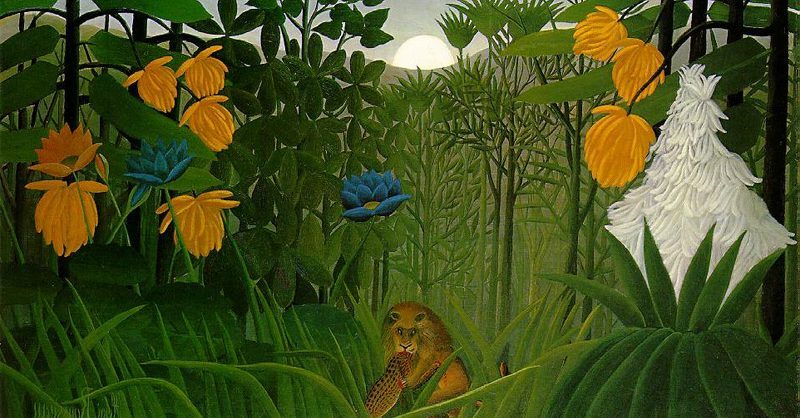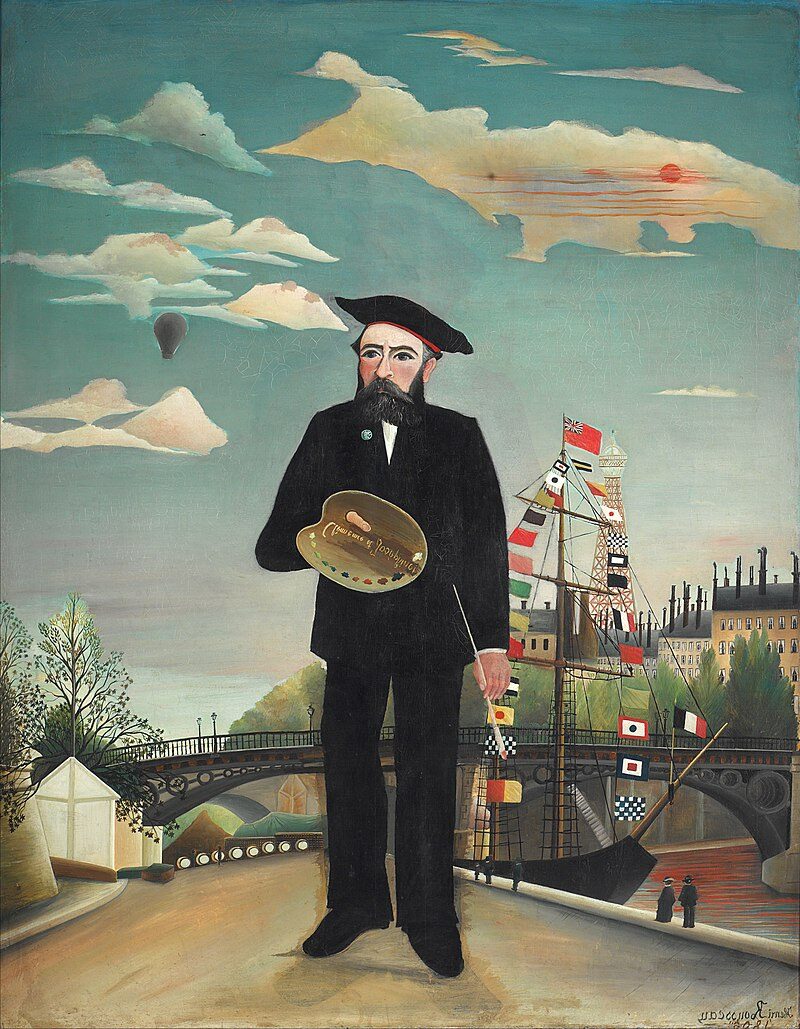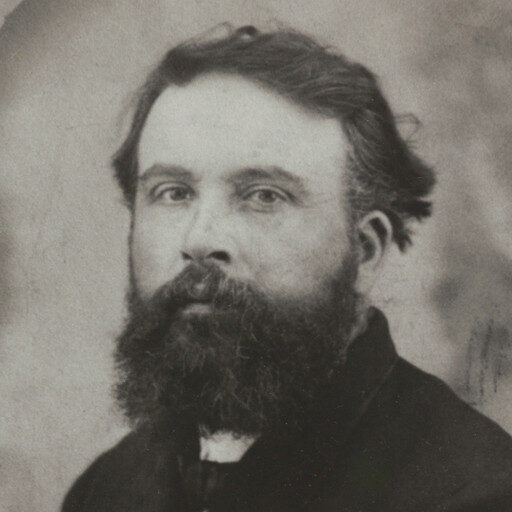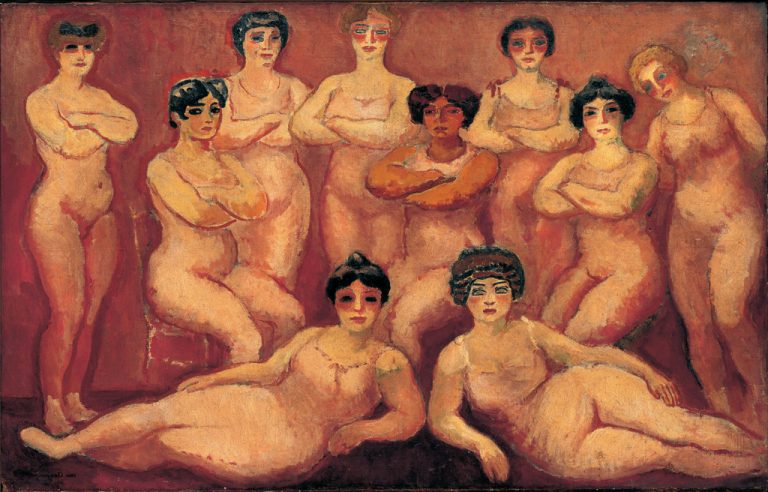Henri Rousseau Painter: The Self-Taught Master of Post-Impressionist Art
Born: 21 May 1844, Laval, France
Death: 2 September 1910, Paris, France
Art Movement: Post-Impressionism, Naïve art, Primitivism
Nationality: French
Teacher: Self-taught
Henri Rousseau Painter: The Self-Taught Master of Post-Impressionist Art
Life and Career of Henri Rousseau
Henri Rousseau led a remarkable life. He transitioned from a customs officer to a self-taught painter who would influence major art movements. His journey from obscurity to recognition involved exotic inspirations and important connections with leading artists of his time.
Early Life and the Path to Painting
Henri Julien Félix Rousseau was born on May 21, 1844, in Laval, France. His path to artistic fame was unconventional. Unlike most renowned painters, Rousseau had no formal training in art.

War or The Ride of Discord, 1894 by Henri Rousseau
He worked as a toll collector in Paris, which earned him the nickname “Le Douanier” (the customs officer). This title stuck with him throughout his artistic career.
At age forty-nine, Rousseau retired from his customs post to dedicate himself fully to painting. Before this, he had been painting as a Sunday amateur, developing his distinctive style in his spare time.
His late start in art didn’t hinder his productivity or passion. Rousseau exhibited his work almost annually from 1886 onward at the Salon des Indépendants in Paris.
The Lure of the Exotic: Botanical Gardens influences
Rousseau never traveled to tropical locations, yet he created stunning jungle scenes that captivated viewers. His exotic landscapes came from a different source of inspiration.
The Paris Botanical Gardens provided Rousseau with visual references for his lush jungle paintings. He studied the tropical plants there in detail, transforming them into wild fantasy landscapes on canvas.
His imagination filled in the gaps between what he observed in the gardens and the exotic worlds he created. These jungle scenes became his most famous works.
The contrast between Rousseau’s limited travel experience and his vivid depictions of far-off places added to the unique quality of his art. His jungle paintings combined realistic botanical details with dreamlike compositions.
Recognition and Relationships with Avant-Garde Artists
Initially, critics mocked Rousseau’s unconventional style. His work appeared naive and simplistic compared to academic standards of the time.

The Flamingoes, 1907 by Henri Rousseau
However, progressive artists saw brilliance in his direct approach. Pablo Picasso discovered Rousseau’s work and became an ardent supporter. In 1908, Picasso even held a banquet in Rousseau’s honor.
Other avant-garde artists and intellectuals also championed Rousseau’s unique vision. They appreciated the authenticity and freshness of his self-taught style.
Despite this growing recognition, Rousseau faced financial struggles throughout his life. True acclaim came mostly after his death in Paris on September 2, 1910.
Today, his paintings hang in major museums worldwide. Rousseau’s work influenced numerous art movements, including Surrealism and modern Primitivism.
Artistic Style and Major Works
Henri Rousseau developed a unique artistic style that combined vibrant colors, precise details, and dreamlike atmospheres. His work stands out for its bold compositions and childlike perspective despite his lack of formal training.
Signature Theme: Jungle Paintings
Rousseau’s jungle scenes remain his most celebrated works, despite the fact that he never left France. “Tiger in a Tropical Storm” (1891) showcases his ability to create tension through a prowling tiger amid stylized foliage during a rainstorm.
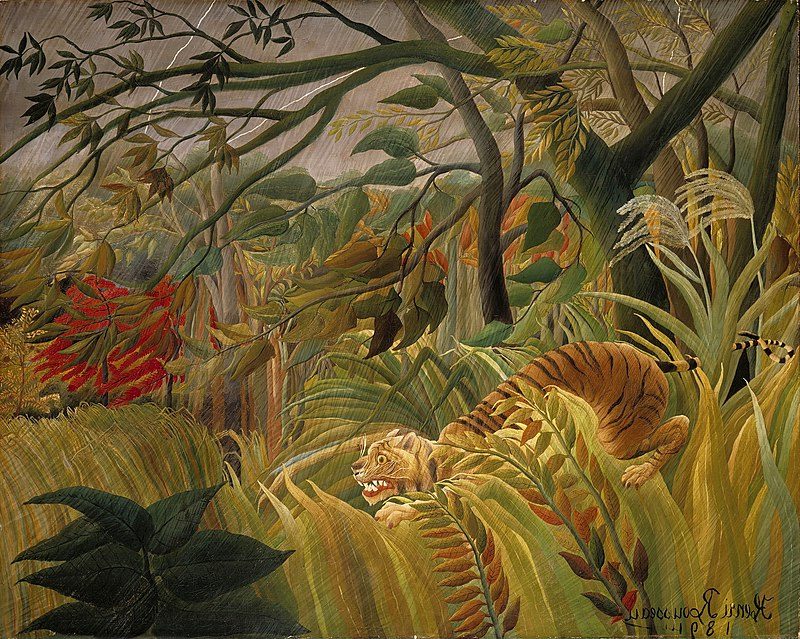
Tiger in a Tropical Storm (Surprised!), 1891 by Henri Rousseau
The lush vegetation in these paintings features impossible combinations of plants rendered with meticulous attention to detail. Each leaf appears individually crafted with sharp edges and strong outlines.
“The Hungry Lion Throws Itself on the Antelope” (1905) demonstrates his dramatic approach to wildlife, presenting a violent scene with flattened perspective and vibrant colors. The dense, detailed foliage creates an almost claustrophobic atmosphere.
His jungle works typically feature perfectly delineated plants in unrealistic sizes and arrangements, creating environments that feel both familiar and otherworldly.
Exploring Rousseau’s Dreamlike Landscapes
“The Dream” (1910) represents the height of Rousseau’s imaginative landscapes. In this painting, a nude woman reclines on a velvet sofa mysteriously placed in a jungle setting with animals peering through vegetation.

The Dream, 1910 by Henri Rousseau
Rousseau’s landscapes feature distinctive flat planes and lack traditional perspective. His color palette includes bold greens and blues that create an otherworldly atmosphere.
“The Sleeping Gypsy” (1897) depicts a wandering musician sleeping under a night sky with a lion standing beside her. The simplified forms and moonlit landscape create a surreal, poetic quality.
His dreamscapes combine precise rendering with impossible scenarios, giving viewers the sense of stepping into a children’s storybook illustration brought to life.
Portraiture and City Dweller Perspectives
Beyond his exotic scenes, Rousseau created striking portraits and urban landscapes. “Portrait-Landscape” (1890) blends a human subject with environmental elements in an innovative approach to traditional portraiture.

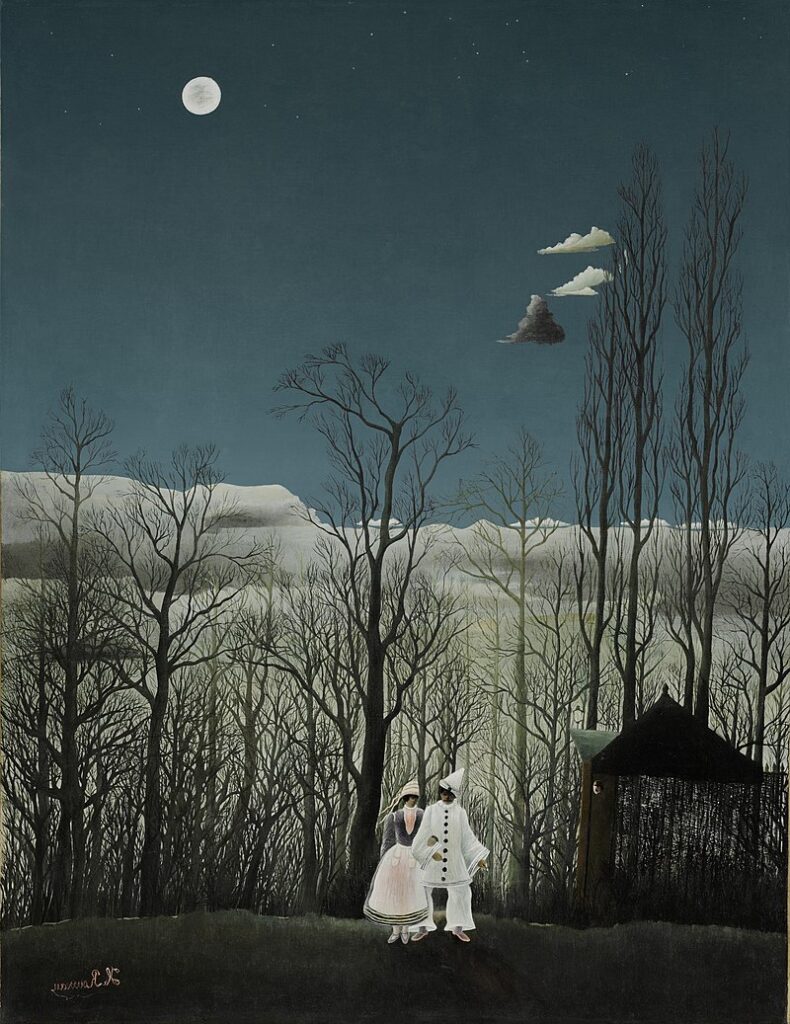
“Carnival Evening” (1886) captures figures in a wintry landscape, demonstrating his skill at depicting city dwellers against stark backgrounds. The figures appear stiff and puppet-like, a characteristic trait of his human subjects.
“Boy on the Rocks” (1895-97) showcases Rousseau’s sensitive approach to portraiture, especially of children. The painting demonstrates his ability to capture innocence through simplified forms.
“Liberty Inviting Artists” (1906) reveals Rousseau’s patriotic themes and allegiance to French artistic traditions. His urban scenes display the same precise detail as his jungles but with architectural focus.
Cultural Impact and Legacy
Henri Rousseau’s artwork continues to captivate audiences worldwide, decades after his death in 1910. His unique “naïve art” style broke conventional norms and influenced numerous artistic movements throughout the 20th century and beyond.
Exhibits and Collections Worldwide
Rousseau’s paintings are housed in prestigious institutions across the globe. The Museum of Modern Art in New York features several of his jungle scenes, while the National Gallery of Art in Washington DC hosted the landmark “Jungles in Paris” exhibition that highlighted his exotic landscapes.
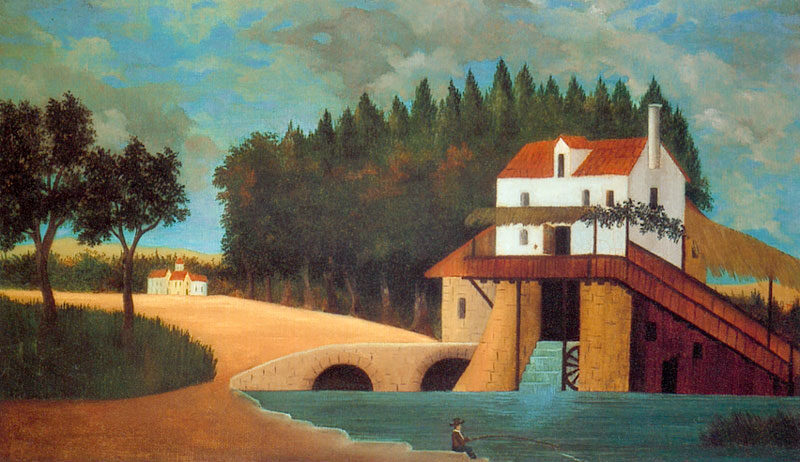
Le Moulin (The Mill), c. 1896 by Henri Rousseau
The Musée d’Orsay in Paris holds a significant collection of his works, including “The Snake Charmer” (1907). The Tate Gallery in London and the Philadelphia Museum of Art also display important Rousseau pieces.
Recent exhibitions have reexamined Rousseau’s contributions to art history. His work appears frequently in shows focused on self-taught artists and early modernism. These exhibits typically emphasize how his unconventional approach challenged academic traditions.
Influence on Surrealists and Modern Artists
Rousseau profoundly impacted later artistic movements, particularly Surrealism. His dreamlike jungle scenes with their flattened perspective and mysterious atmosphere directly inspired Surrealist painters including Max Ernst.
The Fauves, especially Henri Matisse, admired Rousseau’s bold use of color. Members of the Blaue Reiter group in Germany appreciated his direct, emotional approach to painting. Pablo Picasso famously held a banquet in Rousseau’s honor in 1908, recognizing his importance to modern art.
Rousseau’s treatment of space and form, breaking from traditional perspective, influenced artists throughout the 20th century. His work provided an alternative path to abstraction – one based on imagination rather than formal academic training.
Rousseau’s Enduring Inspiration in Art and Popular Culture
Rousseau’s visual language continues to resonate in contemporary art and culture. His jungle scenes have become iconic, frequently referenced in fashion, advertising, and design. Children’s book illustrations often draw from his vibrant, stylized depictions of nature.

The Sleeping Gypsy, 1897 by Henri Rousseau
Musicians have found inspiration in Rousseau’s work too. The band Talking Heads used his painting “The Sleeping Gypsy” as album artwork. Filmmakers, including Wes Anderson, have cited his influence on their visual style.
Contemporary artists still draw from Rousseau’s approach. His self-taught technique encourages artists working outside traditional paths. On Wikipedia and social media, his striking images are among the most shared examples of early modern art, introducing new generations to his work.
Frequently Asked Questions
Henri Rousseau left behind a legacy of unique artwork that continues to intrigue art enthusiasts. His distinct style and techniques have sparked many questions about his creative process and influence on modern art.
What are the defining characteristics of Henri Rousseau’s jungle paintings?
Rousseau’s jungle paintings feature dense, lush vegetation with precise details. Each leaf and plant is meticulously rendered with sharp outlines and vibrant colors.
Animals and human figures appear in these works with a dreamlike quality. Though Rousseau never left France, his imagination created exotic jungle scenes that feel both mysterious and enchanting.
His jungle works typically have a flat perspective without traditional depth. This distinctive approach creates a tapestry-like quality where foreground and background elements seem to exist on the same plane.
What techniques did Henri Rousseau employ in his painting process?
Rousseau was self-taught and developed unique techniques outside formal training. He often built his paintings in layers, starting with a base color and adding elements one by one.
He used small brushes to create precise details in his works. This attention to detail allowed him to render each leaf, feather, and fur with remarkable clarity.
Rousseau typically outlined his subjects clearly before filling them with color. This technique gave his work the distinctive bold lines that have become his trademark.
What is the significance of ‘The Hungry Lion Throws Itself on the Antelope’ in Rousseau’s body of work?
‘The Hungry Lion Throws Itself on the Antelope’ represents Rousseau’s mature style and confident approach to dramatic scenes. Created in 1905, it showcases his ability to depict wild animals in tense, dramatic moments.
The painting gained significance when Pablo Picasso discovered it. This exposure helped bring Rousseau’s work to the attention of the avant-garde art community in Paris.
The piece demonstrates Rousseau’s fascination with the primal aspects of nature. Its vivid depiction of predator and prey became an important influence on later Surrealist artists.
Can you list notable elements that distinguish Henri Rousseau’s painting style?
Rousseau’s style features precise linework with clear outlines around subjects. This technique gives his paintings a distinct, almost illustrative quality.
His color palette tends toward rich, saturated hues with limited shading. This approach creates a vibrant but somewhat flat appearance that became his signature look.
Rousseau often painted subjects at different scales within the same composition. This disregard for realistic proportions creates a dreamlike, fantastical atmosphere in his works.
How has Henri Rousseau influenced modern art with his tiger paintings?
Rousseau’s tiger paintings inspired Surrealist artists with their dreamlike qualities. Artists like Salvador Dalí admired how Rousseau blended reality with imagination in these works.
Modern naive artists look to Rousseau as a pioneering figure. His untrained approach proved that formal education wasn’t necessary to create powerful, emotionally resonant art.
His tiger paintings demonstrated that simplicity could be powerful. This concept influenced many 20th-century art movements that sought to strip away academic conventions.
What factors contribute to the valuation of Henri Rousseau’s paintings in the art market?
Rousseau’s limited output makes his original works rare and valuable. With relatively few paintings in existence, each piece commands significant interest from collectors.
His influence on major art movements increases his market value. Connections to Surrealism, Primitivism, and Post-Impressionism have elevated his historical importance.
Museums’ interest in his work has boosted private market values. Major institutions like MoMA and the National Gallery showcase his paintings, confirming his place in art history and driving collector demand.

